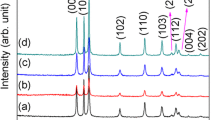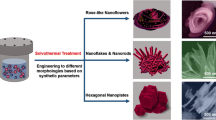Abstract
Control of the morphology and the aspect ratio of zinc oxide nanostructures by varying mainly the anionic and cationic strengths of the mother solution in the hydrothermal process is reported. This is studied by choosing five different cationic ([Zn2+]) concentrations in two different anionic ([OH−]) concentrations each, giving totally ten combinations. A change in the concentration of the mother solution greatly altered the size and the aspect ratio of the nanostructures, as seen in the scanning electron microscopy images of the nanostructures. Changing the ionic strength directly influenced the growth parameters such as the interfacial energy and the formation of nuclei, which resulted in different nanostructures. By using an X-ray diffraction analysis, we confirmed the produced nanostructures to be wurtzite-structured hexagonal zinc oxide in all cases. A characteristic predominant growth along the polar planes with angular tips was also observed by using transmission electron microscopy.
Similar content being viewed by others
References
J. H. Kim, D. Andeen and F. F. Lange Adv. Mater. 18, 2453 (2006).
S. D. Gopal Ram, M. Anbu Kulandainathan and G. Ravi, Appl. Phys. A 105, 881 (2011).
X. Wang, J. Zhou, C. Lao, J. Song, N. Xu and Z. L. Wang, Adv. Mater. 19, 1627 (2008).
K. Biswas, N. Varghese and C. N. R. Rao, J. Mater. Sci. Technol. 24, 615 (2008).
Y. Lee, Y. Zhang, S. L. Geok Ng, F. C. Kartawidjaja and J. Wang, J. Am. Ceram. Soc. 92, 1940 (2009).
T. I. Shin, H. J. Lee, J. H. Lee, S.-W. Kim, S. J. Suh and D. H. Yoon J. Cryst. Growth 292, 216 (2006).
L. Vayssieres, Int. J. Nanotechnology 1, 1 (2004).
P. X. Gao and Z. L. Wang, Small 1, 945 (2005).
X. Gao, X. Li and W. Yu J. Phys. Chem. B, 109, 1155 (2005).
D. Kaushik, R. R. Singh, M. Sharma, D.K. Gupta, N. P. Lalla and R.K. Pandey Thin Solid Films 515, 7070 (2007).
W. Peng, S. Qu, G. Cong and Z. Wang Cryst. Growth. Des. 6, 1518 (2006).
Author information
Authors and Affiliations
Corresponding author
Rights and permissions
About this article
Cite this article
Gopal Ram, S.D., Kang, T.W. & Ravi, G. Ionic-strength induced control of the shape and the aspect ratio of ZnO nano-structures prepared by using the hydrothermal process. Journal of the Korean Physical Society 63, 214–217 (2013). https://doi.org/10.3938/jkps.63.214
Received:
Accepted:
Published:
Issue Date:
DOI: https://doi.org/10.3938/jkps.63.214




